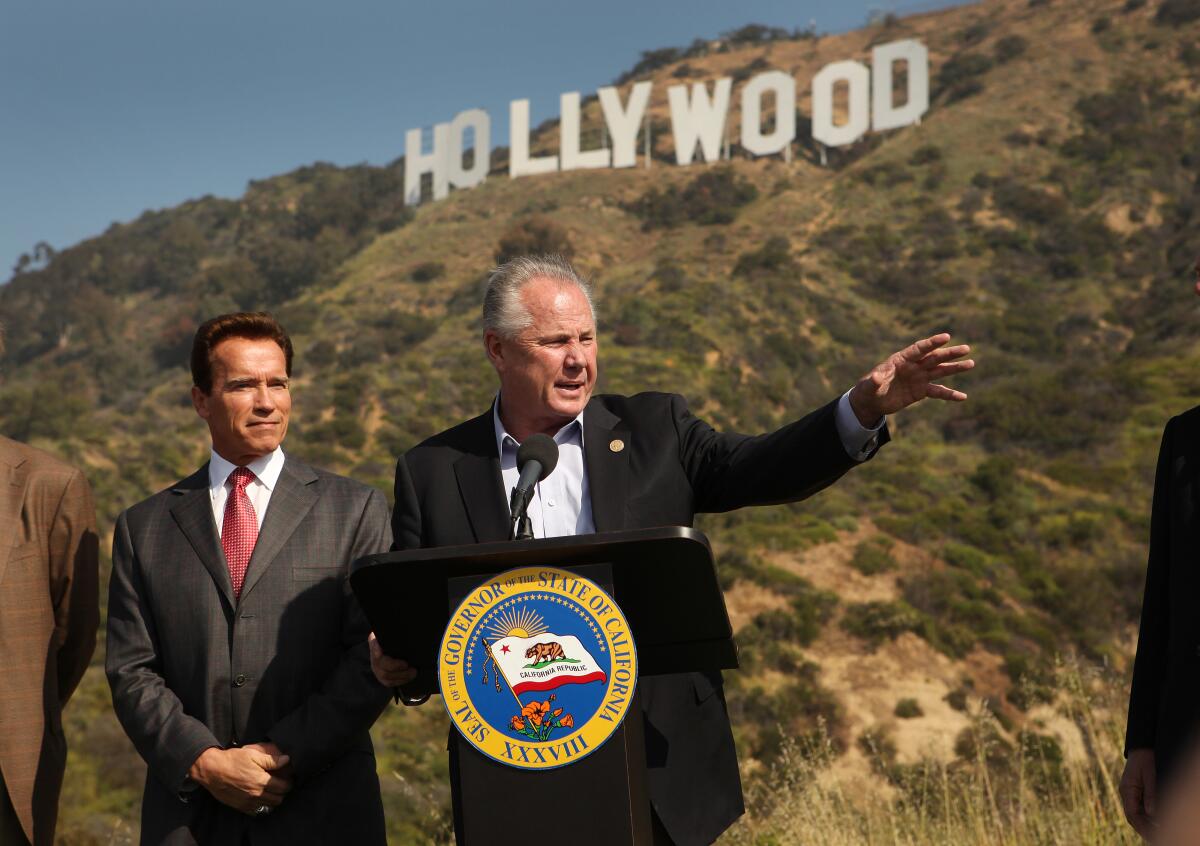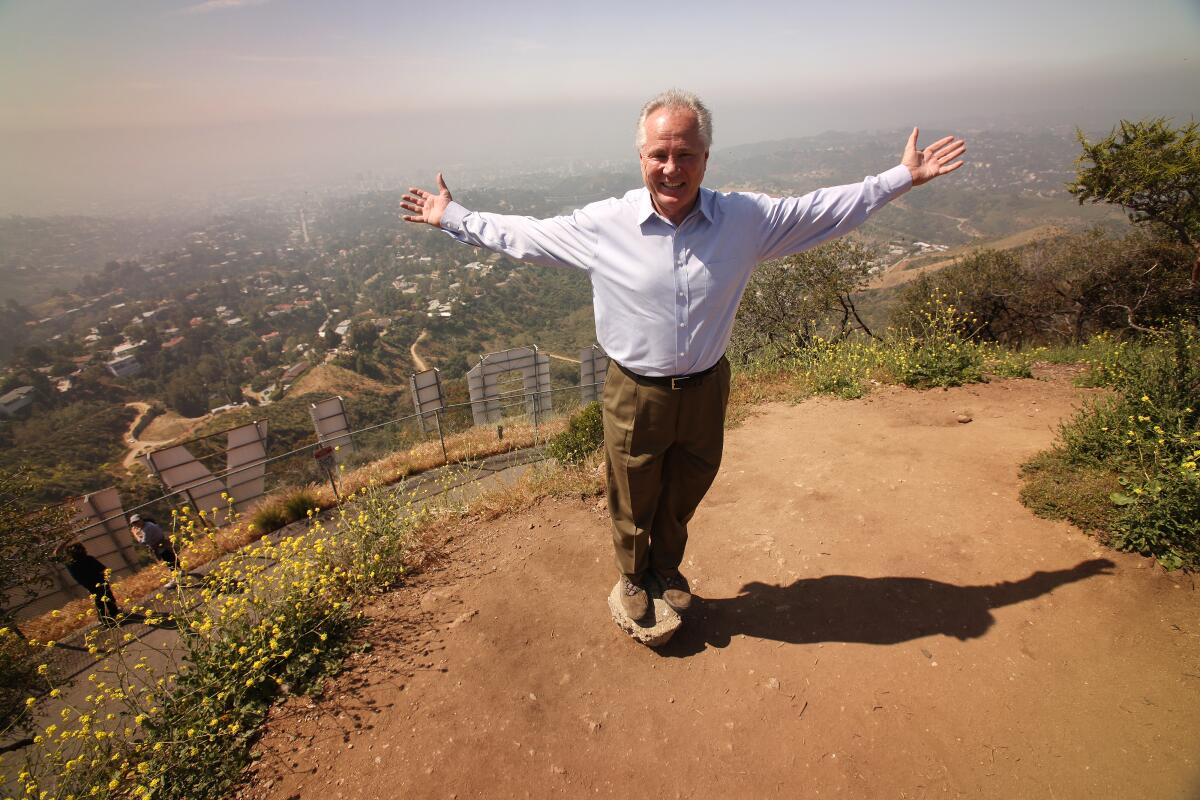Former L.A. Councilman Tom LaBonge, known to many as ‘Mr. Los Angeles,’ dies at 67
- Share via
Former Los Angeles City Councilman Tom LaBonge adored Los Angeles.
The 39-year veteran of City Hall regularly asked Angelenos to name their favorite L.A. buildings. He handed out calendars featuring his photographs of the city and loaves of pumpkin bread baked by local nuns. He was a champion of Griffith Park, hiking there every day, and worked to expand its size by hundreds of acres.
When voters considered breaking up the city into two or three pieces, LaBonge made clear he was passionately opposed.
If secession were approved, “the sun would rise and all the other things would happen,” LaBonge told The Times in 2002, before the vote. “But it would personally hurt me.”
LaBonge, who served on the City Council from 2001 to 2015, died Thursday. He was 67. Brigid, his wife of 41 years, said she had been unable to wake him up after he had been resting on the couch. Paramedics were called to their Silver Lake home. No cause of death was given.
“He was a good person,” she said.

LaBonge was well known for his love of the city’s history, its landmarks, its public spaces and its people — and his eagerness to celebrate all of those things. He frequented Pink’s Hot Dogs on La Brea Avenue and Philippe’s in Chinatown and had a bottomless wealth of city trivia.
For much of his time in office, he could be seen driving around the city in his Ford Crown Victoria, climbing out to regale constituents and tourists alike.
“He was such an irrepressible cheerleader for Los Angeles — a walking encyclopedia of all the amazing things and spots and neighborhoods and institutions in L.A.,” said Councilman Mike Bonin, who represents the city’s coastal neighborhoods. “He was the Huell Howser of L.A. politics, a spirit that was always optimistic and in love with the city.”
Councilman Mitch O’Farrell, whose district bordered LaBonge’s, described him as a “force of nature.” Council President Nury Martinez, posting on Instagram, highlighted his ability to connect with the public.
“He knew every mascot of every high school in Los Angeles for a reason — so he could engage people and talk to them about their lives,” she said.
Los Angeles County Supervisor Janice Hahn, who served on the council for roughly a decade, said she did not know if anyone would ever love the city as much as LaBonge.
“He was and will always be Mr. Los Angeles,” she wrote.
LaBonge was born Oct. 6, 1953, in Los Angeles and grew up in Silver Lake, the seventh of eight boys. His father, Robert LaBonge, worked for the Tidings, a Catholic newspaper, and his mother, Mary Louise was a homemaker.
A graduate of John Marshall High School and Cal State Los Angeles, LaBonge got his first taste of public service in 1974 with Mayor Tom Bradley’s youth council. Two years later, he secured a job with Councilwoman Peggy Stevenson.
In 1978, LaBonge began a 15-year stint with Councilman John Ferraro, whose district he went on to represent decades later. He ran for City Council in 1993 but lost to Jackie Goldberg, who had served on the school board. That same year, he became an aide to Mayor Richard Riordan. He also worked for a time at the Department of Water and Power.

During his time in office, LaBonge acknowledged he focused less on the finer points of public policy and more on delivering nuts-and-bolts city services. Carolyn Ramsay, a former high-level LaBonge aide, recalled standing outside with the councilman in the rain in the early morning hours, working to clear leaves out of storm drains to prevent them from flooding.
LaBonge also took a special interest in trash pickup, working to remove furniture that was regularly deposited on the sidewalks of Silver Lake, Los Feliz, Hollywood, Hancock Park, Miracle Mile and other parts of his district.
Alarmed by the sight of garbage in his district, LaBonge would at times stop the car, pop the trunk and pull out a rake, said Jane Galbraith, a former spokeswoman for the councilman and longtime friend.
“He could not pass a piece of trash on the sidewalk or in the park without picking it up,” Galbraith said.
By the time LaBonge left office, the city had a trash truck named after him.
LaBonge was also proud of his involvement with the Sister Cities program, which connected Los Angeles with cities around the world, and his work in adding new walking trails, bike paths, soccer fields and stop signs, as well as the restoration of the Griffith Observatory, Galbraith said.
Still, some at City Hall rolled their eyes at LaBonge’s ebullient and occasionally distracting style of communicating. When council members reviewed plans for a downtown NFL stadium, he marked the proceedings by tossing a football in the chamber.
LaBonge could bring a policy discussion to a halt by asking a bureaucrat, seated earnestly before the council, what high school he or she had attended. And during the 2015 campaign to replace him, some criticized LaBonge for being a “pothole politician,” saying they wanted someone who would explore systemic solutions to city problems.
LaBonge defended his stewardship of the district, saying in a 2015 interview with KPCC-FM’s John Rabe that he grasped his constituents’ needs, even if he lacked a heavy focus on legislation.
“Sometimes I get criticized and they say I’m not a visionary,” he said. “I’m an absolute visionary, and the vision comes from people, and how people feel about their city and where they live.”
Some residents said Friday that they were struck by the extent to which LaBonge took a personal interest in his constituent’s lives.
Earl Ofari Hutchinson, president of the Los Angeles Urban Roundtable, said LaBonge showed up in 2003 at the 100th birthday party for his father, who lived in the Park La Brea section of the councilman’s district. After Hutchinson’s father died, LaBonge had a tree planted in his memory at Pan Pacific Park.
Chris Laib, who lives in Los Feliz, recalled the day in 2007 when LaBonge rescued two of his dogs from a massive fire that broke out in Griffith Park. LaBonge knew that Laib and his husband were out of the country at the time the fire reached the backyard, he said.
“He got in, jumped the gate at great risk to himself and took our dogs to some friends,” Laib said. “That’s the kind of man he is.”
LaBonge, an avid photographer, also was a major supporter of the Los Angeles Public Library and its photo collection. He donated photographs and supported the library’s effort to digitize nearly 41,000 images taken by the Valley Times, a newspaper that folded in 1970, said senior librarian Christina Rice.
On Thursday, hours before his death, LaBonge was on the phone with Rice, saying how nice it would be to have people over at his home once the coronavirus crisis had passed. He also casually mentioned that he was sitting in his backyard on a seat that once had been part of the Los Angeles Memorial Coliseum, Rice said.
“Which is just the most Tom thing,” she said.
In addition to his wife, LaBonge is survived by his daughter Mary-Cate LaBonge and son Charles LaBonge, both of Los Angeles; as well as brothers Brian LaBonge of Glendale, Dennis LaBonge of Newport Beach, Robert LaBonge of Malibu, Timothy LaBonge of Desert Hot Springs and Mark LaBonge of Los Angeles.
More to Read
Sign up for Essential California
The most important California stories and recommendations in your inbox every morning.
You may occasionally receive promotional content from the Los Angeles Times.











